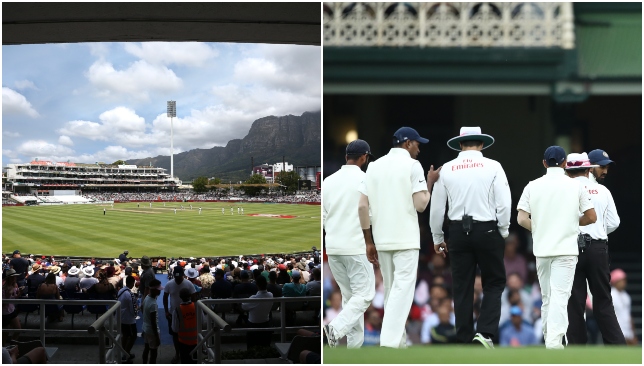
2018 was the year of Test cricket’s revival. Outstanding bowling displays, closely-fought series between some of the world’s best teams,a dearth of draws, a dominant year for bowlers, and international cricket’s premier batsman simply saying it was the best format, repeatedly, just made it so.
Shame it took six days to ruin it in 2019.
First, in South Africa, where the hosts bowled Pakistan out right at the end of Day 3 of the second Test, and had a target of 41 to chase down. For a good half an hour before that moment, South Africa had been looking to wrap up the Pakistan second innings and end the game the same day, hopefully with an innings win or at worst, with a small target to chase down. They thought they had their chance about 15 minutes earlier, when Vernon Philander seemingly had the final wicket of the Pakistan innings, only for it to be called back for a no-ball.
In the 15 minutes it took between then and the actually fall of the final wicket, South Africa’s mentality changed, and they were happy to wait until the next morning to finish the game.
That's stumps, and South Africa wil begin their second innings tomorrow needing 41 runs to win.
— ICC (@ICC) January 5, 2019
Kagiso Rabada and Dale Steyn took four wickets each, but Babar Azam's belligerent half-century ensured the hosts will need to bat again.#SAvPAK SCORE 👇https://t.co/sT3TAzx0C3 pic.twitter.com/5ykdCF2tLI
There were still a good 20 minutes to be played, in bright sunshine, against a demotivated Pakistan bowling attack. 41 in 20 minutes may have been a tall order, but why not go for it, and make everyone’s lives easier?
The umpires, too, chose not to put their feet down – though the extra half hour at the end of the day is a joint decision between them and the relevant captain, South Africa’s Faf du Plessis, and at least in this case they can point to the Proteas’ reluctance, rather than poor decision-making on their part.
Their counterparts in Sydney had no such excuse. With India pushing for a historic series win, a first ever in Australia, on Day 4 of the final Test, the umpires deemed the light not good enough to play. It’s a shame they were playing at a small provincial ground with inadequate lighting, and not, say, Sydney Cricket Ground, with newly-installed floodlights that could probably allow play to happen at midnight, if people were so inclined.
No, wait. This was at the SCG.
The umpires had erred the day before, taking players off for bad light prematurely, and thus setting that as the standard for “bad light” for the rest of the Test.
So India and Australia spent most of the last three hours of the day waiting in their respective dressing rooms for the umpires to decide if the sun would emerge from the clouds, rather than take the logical option of realising that the floodlights would be good enough to play at least a little.
India could have had two spinners operating, in case the umpires thought fast bowling would be too dangerous in the artificial light. The umpires knew that was an option, and chose not to take it.
Meanwhile, thousands of fans who had paid to come watch cricket on the Sunday of a Sydney Test were shortchanged. They could see the floodlights, but had to sit and watch as no cricket was played all afternoon as the umpires chose not to use the tools at their disposal.
For many of those fans, the option of coming back on Monday wasn’t available, for obvious reasons.
Imagine this: a young boy has driven an hour and more with his father to watch the cricket. All he gets is play stalled for bad light. No rain and yet he sees no play. He says thank you to cricket and moves to football. Is the @ICC @CricketAus @BCCI sensing the pain?
— Boria Majumdar (@BoriaMajumdar) January 6, 2019
Thanks to a recent change in the ICC rules governing playing conditions, the umpires are now allowed to use some amount of personal discretion when making the decision about whether play can happen in these situations. So on-field umpires Richard Kettleborough and Ian Gould, third umpire Marais Erasmus, and match referee Andy Pycroft had the power to make a decision in the best interests of the game being played and the fans in the stadium, and chose not to thanks to an outmoded devotion to rules regarding natural versus artificial light.
There’s no guarantee India would have picked up 10 wickets during the rest of the day, and, ultimately, no play happened on Day 5, either. India had to content themselves with a 2-1 win instead of pushing for a more dominant 3-1 triumph. They celebrated in front of a handful of fans – credit to those who showed up on Monday – instead of something closer to the packed house they had on Sunday.
But there’s no doubting that what happened in Cape Town on Saturday and Sydney on Sunday were farces that did a disservice to cricket. Not the greatest advert for a sport that is already in the middle of a crisis over attracting fans and staying relevant.
Cricket is funny game with at times quirky rules, and sometimes that’s part of the charm. Especially so with Test cricket. But the fact that it can’t understand one simple principle – when people are waiting for you to play, and you can play, just play – means it keeps shooting itself in the foot.